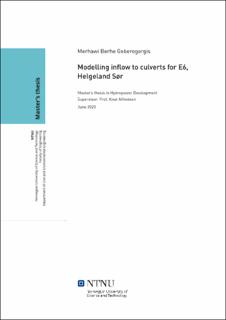| dc.description.abstract | The estimation of flood peak discharge is a primary and vital step which is required in the design and safety assessment of hydraulic structures. The commonly used methods for estimating the flood peaks in small ungauged catchments such as rational method and the Norwegian rainfall-runoff model, PQRUT, are simple event based methods that contain parameters difficult to estimate and/or have an issue related to the pre-event antecedent moisture conditions. The continuous hydrological models for estimating the design flood discharges have been getting more attention recently. In this study, the DDD continuous hydrological model on an hourly time step is applied for estimating the 200-year flood peak discharges for seven small ungauged catchments located in Norway. The DDD model parameters have been determined by regionalization methods, the combination of the multiple-regression method and the pooling group-based physical similarity method. The DDD model performance was tested in another two gauged catchments at around the same area prior to flood peak estimation for the study catchments. The regionalized DDD model simulation reproduced the observed discharges satisfactorily (0.5 ≤ KGE ≤ 0.75) for both test catchments. The study analyzed the effect of pre-event catchment conditions on generating flood peak discharges. Application of the DDD model indicated high sensitivity to the catchment condition. The results show that flood peak estimate produced by a combination of design rainfall and snowmelt condition contributed to the potential flood peaks, whereas the combination of design rainfall with dry catchment conditions gave the lowest flood peak results. The computed flood estimates using the DDD model were compared to an existing design flood estimates by three methods, namely; the rational method, NIFS formula and regional analysis. The DDD model flood peak estimates showed a discrepancy in the catchment size. Robust flood peak estimates using the model produced during the combination of design rainfall and snowmelt condition for the three relatively bigger catchments. In contrast, the DDD model resulted in an underestimation of flood peaks more often in the two tiny catchments. | |
